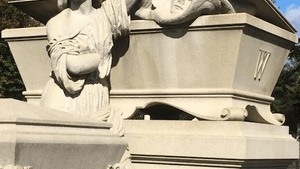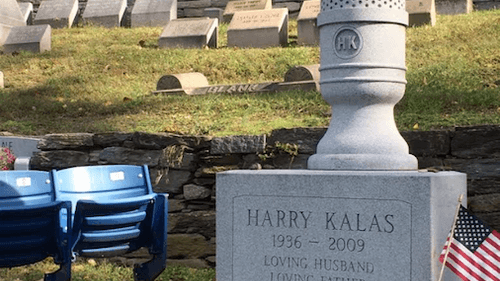Stay in the Loop
BSR publishes on a weekly schedule, with an email newsletter every Wednesday and Thursday morning. There’s no paywall, and subscribing is always free.
Days of the dead
Laurel Hill Cemetery's 'Hot Spots and Storied Plots' tour

When Laurel Hill Cemetery opened in 1836, the grounds lay four miles from Center City via a rutted cart-path (now Ridge Avenue). But it was an easy steamboat ride up the Schuylkill to the cemetery’s riverside entrance, where mourners and pallbearers would heft caskets up the hill on foot.
Laurel Hill’s four founders envisioned a rural resting place far from the grime and crowds of the growing city, with its tight blocks and oversubscribed churchyards, a non-denominational cemetery with a breathtaking (pun intended) view of the river.
They also saw burial as lucrative business.
Back then, interment at Laurel Hill cost a minimum of $50 ($1,200 in today’s dollars). The founders were savvy marketers, petitioning the descendants of some well-known Philadelphians to have their graves moved from family farms or churchyard plots to the greener pastures of Laurel Hill.
Seeding the lawn
“They thought the best way to open the cemetery would be to seed it with famous people,” says Steve Chawaga, attorney by trade and Laurel Hill guide for the past four years. The tactic worked: not only did Laurel Hill become the go-to resting place for spiritualists and revolutionaries, surgeons and sergeants, inventors and industrialists, but it drew — and continues to draw — visitors to stroll, bicycle, picnic, photograph and muse about the history buried beneath their feet.
Twice a month, on the second Saturday and fourth Friday, Chawaga and other guides give the Hot Spots and Storied Plots tour of Laurel Hill, a two-hour walk punctuated with tales of some of the cemetery’s illustrious residents.
It’s also a crash course in Victorian cemetery symbolism, a sociological glimpse (Who’s got the biggest tomb? Who was left out of the family plot?), and a prime photo op, with weather-stained grave markers chalky against a backdrop of Wedgewood blue and autumn ochre.
It’s Chawaga’s stipulation that instills your trust. “Almost all of what I tell you is true,” he says affably, then goes on to detail, without notes, the specs of Laurel Hill. The place spans one mile from end to end, covers the area of 80 football fields and contains more than 30,000 monuments. Probably 80,000 people are buried there. (And you can be, too, though space is limited and the best real estate, by the river, is long gone.)
Fiction and folly
This past Friday, the first grave visited by Chawaga’s group — about 25 people, mostly locals — was actually a faux-grave, the granite marker for “Adrian Balboa,” who married Rocky in the eponymous movies. She died, Chawaga deadpans, “sometime between Rocky V and Rocky Balboa. He built a set and left everything here.”
But just a few feet away is the real thing, a truth stranger than cinematic fiction. A zinc-plated obelisk, jammed with text on all sides, marks the burial spot of Levi F. Smith and Catharine Drinkhouse Smith, well-known 19th-century spiritualists. One of the panels reads, “LIFE is eternal; DEATH is merely a change of conditions.”
We’re now on a rise that lets us gaze down at the colonnaded gatehouse — “Greek Revival, but not in-your-face Greek Revival,” Chawaga says — designed by John Notman (1810-1865), buried nearby. Chawaga points out that the vast majority of the monuments are understated — “Philadelphians in the 1860s and 1870s were not showy, even in death” — though “Millionaires’s Row” does hold family tombs the size of my first apartment, including one with an original Tiffany stained glass.
Furness, Calder, and more

Among the interred are revolutionary and Civil War heroes — Joseph Reed, who was George Washington’s aide de camp, and George Gordon Meade, the commander of Union troops during the Battle of Gettysburg (“He did his work bravely and is at rest,” assures the marker.)
Architect Frank Furness is here, with a gravestone that bears no evidence of his artistic resume. The opposite is true for Harry Kalas, the famed Phillies’ announcer (1936-2009) who has a giant granite microphone and blue seats salvaged from Veterans’ Stadium to mark his spot.
There are people you’ve never heard of — Charles Thomson, for instance, who designed the Great Seal of the United States (right, the eagle image that won out over Benjamin Franklin’s suggestion of a turkey) and who kept minutes of the Continental Congress in his spidery penmanship. Thomas McKean, a signer of the Declaration of Independence. Elisha Kent Kane, an explorer who combed the Arctic wilderness.
Chawaga is fluent in Victorian gravesite symbolism: the broken column that signifies a life cut short; the urn, emblematic of the body as vessel for the soul; and the creepiest (in my view), the winged face emerging from the Warner tomb, sculpted by Alexander Milne Calder (right, the same one who designed the statues adorning City Hall).
A stroll through Laurel Hill bears testament to what stays the same (a man whose election as district attorney was invalidated because dead people had voted for him) and what erodes with time (literally, the inscriptions on many of the marble stones). The past, if you’re paying attention, always churns up more questions than it answers: “Was Thomson (1729-1824, dead before Laurel Hill was built) really disinterred from his former plot on the Harriton family farm? Who was Jane Berlin McDowell Vansant, and why is the headstone next to hers marked only ‘husband’?”
Meanwhile, a freight train huffs in the near distance; rowers cut khaki lines in the river below. The cemetery is open seven days a week, and if you’re so inclined, you can buy a souvenir: Victorian mourning jewelry, Day of the Dead cookie cutters, or a t-shirt asserting that Laurel Hill is “the liveliest cemetery this side of eternity.” And who can argue that?
What, When, Where
Hot Spots and Storied Plots. Monthly, fourth Fridays and second Saturdays at the Laurel Hill Cemetery, 3822 Ridge Ave., Philadelphia. (215) 228-8200 or thelaurelhillcemetary.org.
Sign up for our newsletter
All of the week's new articles, all in one place. Sign up for the free weekly BSR newsletters, and don't miss a conversation.

 Anndee Hochman
Anndee Hochman